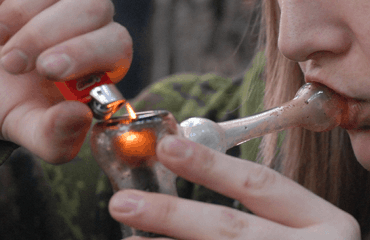- What Are the Effects of Spice?
- How "K2" Addiction Changes Your Life
- K2 Addiction and Mental Health
- Sources
- What Are the Effects of Spice?
- How "K2" Addiction Changes Your Life
- K2 Addiction and Mental Health
- Sources
What is Spice?
Spice is a synthetic cannabinoid, which affects the same neurotransmitters as marijuana (the CB1 receptor).
K2/Spice is much more potent than ?9-THC (the psychoactive ingredient in marijuana), and therefore, much more toxic in its effects.
What Are the Effects of Spice?
Spice has numerous immediate and long-term effects.
Immediate Effects
Onset of effects can occur within minutes of smoking K2 or Spice, with the duration varying greatly depending on the specific constituents and cannabinoids present in the product.
Immediate effects can include the following:
- Euphoria.
- Feelings of well-being.
- Calmness.
- Relaxation.
- Increased creativity.
- Mild memory impairments.
- Changes in perception like altered depth perception, tingling, and peripheral numbness.
- Slurred speech
- Tremors.
- Ataxia (poor coordination).
Medical complications include:

- Tachycardia (rapid heartbeat).
- Anxiety.
- Suicidal ideation.
- Hypertension.
- Kidney injury.
Psychological complications include:

- Hallucinations.
- Delirium.
- Paranoia.
- Psychosis.
- Severe psychomotor agitation.
- Anxiety.
There have been numerous reports of negative effects of K2/Spice lasting longer than the period of intoxication--particularly related to poor coordination--that can complicate tasks such as driving and operating machinery. If you are suffering from an addiction to Spice,
please call
1-888-993-3112Who Answers? to find a treatment program that's right for you.
Long-Term Effects of K2/Spice.
The reports of the harmful effects of K2 and Spice also highlight the potential for persistent mental health changes:
- It has been reported that individuals who are susceptible to psychosis can experience symptoms like paranoid hallucinations at a higher intensity than what would be normal.
The newer formulations of K2 and spice have greater neurological affinity than THC - they bind better to the CB1 receptor - and this may result in an increased vulnerability for developing mental disorders such as major depressive illness. Further, long-term dangers are compounded by the absence of cannabidiol (CBD) in K2 and Spice.
According to research in both animal and human studies, CBD has anxiety-relieving effects, primarily due to its actions on the limbic and paralimbic brain regions. It is speculated that these positive effects may offset the negative effects of marijuana; a phenomenon that is not shared by Spice or K2.

Lasting harmful effects aren't limited to the realm of mental health.
Severe medical issues can also arise in individuals abusing these substances, and can include:
- Rhabdomyolysis (breakdown of muscle) followed by kidney failure, resulting directly from problems with metabolizing K2, has been frequently reported in the literature.
- Acute myocardial infarction (heart attack).
- Respiratory depression.
Dependence
The clear development of a Spice dependency has not been adequately uncovered in research, but a few symptoms have been mentioned in case presentations. These include:
- Depression.
- Profuse sweating.
- Diarrhea.
- Nausea.
- Vomiting.
- Tremor.
- Palpitations.
- Insomnia.
Tolerance
Case reports suggest that chronic use leads to the development of tolerance, subsequently increasing drug use and concomitant heightened risk of experiencing negative mental and medical health effects.
Withdrawal
Compared to other drugs of abuse, a withdrawal syndrome in K2 and Spice users with accurate symptomatology and development is not well characterized. Most of our knowledge comes from case-reports.
The withdrawal syndrome is characterized by anxiety and tachycardia, and the withdrawal intensity is more severe than regular marijuana because of the potency of Spice.
Other symptoms include:
- Agitation.
- Profuse sweating.
Dependence and chronic use are marked by
craving, which is an
overwhelming desire to use the drug; it is precipitated by the physiological and psychological effects of the drug. If you are struggling under the weight of Spice addiction, you need to seek treatment in order to get better.
Please call
1-888-993-3112Who Answers? to speak with one of our treatment support staff today.
How "K2" Addiction Changes Your Life
A frequent reason why addiction gets attention is its impact on society; drug abuse certainly harms at an individual level, but also has the potential to impact the lives of others.
An individual addicted to synthetic cannabinoids may undergo major changes in their perception of both themselves and those around them:
- Paranoid delusions.
- Aggressive behavior.
Other substance-induced distortions can precipitate violence towards family, friends, and community.
A growing intolerance on the part of the larger community increases the likelihood that the individual will be seen as deviant, and therefore, stigmatized.
The harmful effects of becoming dependent are similar across drug types.
It can increase your risk of developing , and committing violent acts towards your friends and/or family.
In one study, out of a total of 400 regular drug users:
- 82% admitted to a history of committing crime.
- 41% of them within the past 12 months.
Nearly all of them reported they had been victims of violent crime, 46% in the preceding 12 months.
Drug-related intimate partner violence (IPV) is also common and results in the loss of social relationships. The risk between serious drug involvement and risk for unemployment is well-recognized.

Additionally, recent research suggests that persistent drug use among academic-achieving college students might increase the risk for post-college unemployment. If that is the case, then the traditional understanding of drug-related unemployment being the result of poor education and lack of drive to succeed is no longer a sole factor in the unemployment statistics.
K2 Addiction and Mental Health
Studies propose that over-activation of the endocannabinoid system (the part of the brain affected by THC and synthetic marijuana) can result in neurodevelopmental changes in adolescents and young adults.
These changes can potentially exacerbate or lead to psychosis in this population. The effects of natural cannabis/marijuana on the adolescent brain are well-documented as impacting the development of cognition and memory.
High rates of anxiety disorders, depressive disorders, and schizophrenia have been associated with early marijuana use, so it is reasonable to be concerned about over-activation of the adolescent brain by synthetic cannabinoids.
 Among cannabis users, the prevalence of depression is 25%; and with anxiety disorders, the estimate is 6-16%.
Among cannabis users, the prevalence of depression is 25%; and with anxiety disorders, the estimate is 6-16%.
- 30% of adolescents who heavily use marijuana exhibit depressive symptoms in adulthood.
Acute exposure to both cannabis and synthetic cannabinoids such as K2/Spice can produce a full range of transient, psychotic abnormalities that bear a striking resemblance to symptoms of schizophrenia.
- In individuals who have a psychotic disorder, these chemicals can exacerbate symptoms, trigger relapse, and have negative consequences on the course of the illness.
Sources
- Arria, A.M., et al., (2013). Drug use patterns in young adulthood and post-college employment. Drug Alcohol Depend 127(1-3): 23-30.
- Auw?rter, V., et al., (2013). Synthetic Cannabinoid Receptor Agonists. In Dargan, P.I., and Wood, D.M., eds. Novel Psychoactive Substances: Classification, Pharmacology, Toxicology. Boston: Elsevier, pp.317-343.
- Baumeister, D., et al., (2015). Legal Highs: staying on top of the flood of novel psychoactive substances. Ther Adv Psychopharmacol 5(2): 97-132.
- Brents, L.K., and Prather, P. L., (2014). The K2/Spice phenomenon: emergence, identification, legislation, and metabolic characterization of synthetic cannabinoids in herbal incense products. Drug Metab Rev 46(1): 72-85.
- Daley, D.C., et al., (2011). Relapse Prevention. In Ruiz, P., and Strain, E.C., eds. Lowinson and Ruiz's Substance Abuse: A Comprehensive Textbook. Philadelphia: Lippincott, Williams & Wilkins, pp. 633-647.
- Darkey, S. et al., (2010). Comparative rates of violent crime among regular amphetamine and opioid users: Offending and victimization. Addiction 105(5): 916-919.
- Devries, K.M. et al., (2013). Intimate partner violence victimization and alcohol consumption in women: a systematic review and meta-analysis. Addiction 109: 379-391.
- Gunderson, E.W., et al., (2012). "Spice" and "K2" Herbal Highs: A Case Series and Systematic Review of the Clinical Effects and Biopsychosocial Implications of Synthetic Cannabinoid Use in Humans. The American Journal on Addictions 21: 320-326.
- Fantegrossi, W.E. et al., (2014). Distinct pharmacology and metabolism of K2 synthetic cannabinoids compared to ?9THC: Mechanism underlying greater toxicity? Life Sci 97(1): 45-54.
- Koob, G.F., and Le Moal, M. Neurobiology of Addiction. Boston: Elsevier, p. 15.
- Lubarsky, K. et al., (2014). Understanding the Dangers of Synthetic Cannabinoids: Case Report. J Addict Med 8(4): 288-289.
- Musselman, M.E., and Hampton, J.P., (2014). "Not for Human Consumption": A Review of Emerging Designer Drugs. Pharmacotherapy 34(7): 745-757.
- Nacca, N. et al., (2013). The Synthetic Cannabinoid Withdrawal Syndrome. J Addict Med 7(4): 296-298.
- Patton, A.L. et al., (2013). K2 toxicity: Fatal case of psychiatric complications following AM2201 exposure. J Forensic Sci 58(6): 1676-80.
- Radhakrishnan, R. et al., (2014). Gone to Pot - A Review of the Association between Cannabis and Psychosis. Front Psychiatry 5:54.
- Renard, J. et al., (2014). Long-term consequences of adolescent cannabinoid exposure in adult psychopathology. Front Neurosci 8: 361.
- Rosenbaum, C.D., et al., (2012). Here Today, Gone Tomorrow...And Back Again? A Review of Herbal Marijuana Alternatives (K2, Spice), Synthetic Cathinones (Bath Salts), Kratom, Salvia divinorum, Methoxetamine, and Piperazines. J Med Toxicol 8: 15-32.
- Sbaderna, M., et al., (2013). Spicing Things Up: Synthetic Cannabinoids. Psychopharmacology (Berl) 228(4): 525-540.
- Seely, K.A., et al., (2012). Spice drugs are more than harmless herbal blends: a review of the pharmacology of synthetic cannabinoids. Prog Neuropsychophamacol Biol Psychiatry 39(2): 234-243.
- Shaffer, H.J., and Albanese, M.J. (2005). Addiction's Defining Characteristics. In Coombs, R.H., ed. Addiction Counseling Review. Mahwah, NJ: Lawrence Earlbaum Associates, pp. 3-31.
- Volkow, N. (2013). Dangerous Synthetic Drugs. NIDA presentation by Norma Volkow, M.D., Caucus on International Narcotics Control, United States Senate, Sept. 25, 2013.
- Ware, M.A., and St. Arnaud-Trempe, E. (2009). The abuse potential of the synthetic cannabinoid nabilone. Addiction 105:494-503.
- Zimmermann, U.S., et al. (2009). Withdrawal Phenomena and Dependence Syndrome After the Consumption of "Spice Gold". Dtsch Arztebl Int 106(27): 464-467.
- What Are the Effects of Spice?
- How "K2" Addiction Changes Your Life
- K2 Addiction and Mental Health
- Sources
- What Are the Effects of Spice?
- How "K2" Addiction Changes Your Life
- K2 Addiction and Mental Health
- Sources
What is Spice?
Spice is a synthetic cannabinoid, which affects the same neurotransmitters as marijuana (the CB1 receptor).
K2/Spice is much more potent than ?9-THC (the psychoactive ingredient in marijuana), and therefore, much more toxic in its effects.
What Are the Effects of Spice?
Spice has numerous immediate and long-term effects.
Immediate Effects
Onset of effects can occur within minutes of smoking K2 or Spice, with the duration varying greatly depending on the specific constituents and cannabinoids present in the product.
Immediate effects can include the following:
- Euphoria.
- Feelings of well-being.
- Calmness.
- Relaxation.
- Increased creativity.
- Mild memory impairments.
- Changes in perception like altered depth perception, tingling, and peripheral numbness.
- Slurred speech
- Tremors.
- Ataxia (poor coordination).
Medical complications include:

- Tachycardia (rapid heartbeat).
- Anxiety.
- Suicidal ideation.
- Hypertension.
- Kidney injury.
Psychological complications include:

- Hallucinations.
- Delirium.
- Paranoia.
- Psychosis.
- Severe psychomotor agitation.
- Anxiety.
There have been numerous reports of negative effects of K2/Spice lasting longer than the period of intoxication--particularly related to poor coordination--that can complicate tasks such as driving and operating machinery. If you are suffering from an addiction to Spice,
please call
1-888-993-3112Who Answers? to find a treatment program that's right for you.
Long-Term Effects of K2/Spice.
The reports of the harmful effects of K2 and Spice also highlight the potential for persistent mental health changes:
- It has been reported that individuals who are susceptible to psychosis can experience symptoms like paranoid hallucinations at a higher intensity than what would be normal.
The newer formulations of K2 and spice have greater neurological affinity than THC - they bind better to the CB1 receptor - and this may result in an increased vulnerability for developing mental disorders such as major depressive illness. Further, long-term dangers are compounded by the absence of cannabidiol (CBD) in K2 and Spice.
According to research in both animal and human studies, CBD has anxiety-relieving effects, primarily due to its actions on the limbic and paralimbic brain regions. It is speculated that these positive effects may offset the negative effects of marijuana; a phenomenon that is not shared by Spice or K2.

Lasting harmful effects aren't limited to the realm of mental health.
Severe medical issues can also arise in individuals abusing these substances, and can include:
- Rhabdomyolysis (breakdown of muscle) followed by kidney failure, resulting directly from problems with metabolizing K2, has been frequently reported in the literature.
- Acute myocardial infarction (heart attack).
- Respiratory depression.
Dependence
The clear development of a Spice dependency has not been adequately uncovered in research, but a few symptoms have been mentioned in case presentations. These include:
- Depression.
- Profuse sweating.
- Diarrhea.
- Nausea.
- Vomiting.
- Tremor.
- Palpitations.
- Insomnia.
Tolerance
Case reports suggest that chronic use leads to the development of tolerance, subsequently increasing drug use and concomitant heightened risk of experiencing negative mental and medical health effects.
Withdrawal
Compared to other drugs of abuse, a withdrawal syndrome in K2 and Spice users with accurate symptomatology and development is not well characterized. Most of our knowledge comes from case-reports.
The withdrawal syndrome is characterized by anxiety and tachycardia, and the withdrawal intensity is more severe than regular marijuana because of the potency of Spice.
Other symptoms include:
- Agitation.
- Profuse sweating.
Dependence and chronic use are marked by
craving, which is an
overwhelming desire to use the drug; it is precipitated by the physiological and psychological effects of the drug. If you are struggling under the weight of Spice addiction, you need to seek treatment in order to get better.
Please call
1-888-993-3112Who Answers? to speak with one of our treatment support staff today.
How "K2" Addiction Changes Your Life
A frequent reason why addiction gets attention is its impact on society; drug abuse certainly harms at an individual level, but also has the potential to impact the lives of others.
An individual addicted to synthetic cannabinoids may undergo major changes in their perception of both themselves and those around them:
- Paranoid delusions.
- Aggressive behavior.
Other substance-induced distortions can precipitate violence towards family, friends, and community.
A growing intolerance on the part of the larger community increases the likelihood that the individual will be seen as deviant, and therefore, stigmatized.
The harmful effects of becoming dependent are similar across drug types.
It can increase your risk of developing , and committing violent acts towards your friends and/or family.
In one study, out of a total of 400 regular drug users:
- 82% admitted to a history of committing crime.
- 41% of them within the past 12 months.
Nearly all of them reported they had been victims of violent crime, 46% in the preceding 12 months.
Drug-related intimate partner violence (IPV) is also common and results in the loss of social relationships. The risk between serious drug involvement and risk for unemployment is well-recognized.

Additionally, recent research suggests that persistent drug use among academic-achieving college students might increase the risk for post-college unemployment. If that is the case, then the traditional understanding of drug-related unemployment being the result of poor education and lack of drive to succeed is no longer a sole factor in the unemployment statistics.
K2 Addiction and Mental Health
Studies propose that over-activation of the endocannabinoid system (the part of the brain affected by THC and synthetic marijuana) can result in neurodevelopmental changes in adolescents and young adults.
These changes can potentially exacerbate or lead to psychosis in this population. The effects of natural cannabis/marijuana on the adolescent brain are well-documented as impacting the development of cognition and memory.
High rates of anxiety disorders, depressive disorders, and schizophrenia have been associated with early marijuana use, so it is reasonable to be concerned about over-activation of the adolescent brain by synthetic cannabinoids.
 Among cannabis users, the prevalence of depression is 25%; and with anxiety disorders, the estimate is 6-16%.
Among cannabis users, the prevalence of depression is 25%; and with anxiety disorders, the estimate is 6-16%.
- 30% of adolescents who heavily use marijuana exhibit depressive symptoms in adulthood.
Acute exposure to both cannabis and synthetic cannabinoids such as K2/Spice can produce a full range of transient, psychotic abnormalities that bear a striking resemblance to symptoms of schizophrenia.
- In individuals who have a psychotic disorder, these chemicals can exacerbate symptoms, trigger relapse, and have negative consequences on the course of the illness.
Sources
- Arria, A.M., et al., (2013). Drug use patterns in young adulthood and post-college employment. Drug Alcohol Depend 127(1-3): 23-30.
- Auw?rter, V., et al., (2013). Synthetic Cannabinoid Receptor Agonists. In Dargan, P.I., and Wood, D.M., eds. Novel Psychoactive Substances: Classification, Pharmacology, Toxicology. Boston: Elsevier, pp.317-343.
- Baumeister, D., et al., (2015). Legal Highs: staying on top of the flood of novel psychoactive substances. Ther Adv Psychopharmacol 5(2): 97-132.
- Brents, L.K., and Prather, P. L., (2014). The K2/Spice phenomenon: emergence, identification, legislation, and metabolic characterization of synthetic cannabinoids in herbal incense products. Drug Metab Rev 46(1): 72-85.
- Daley, D.C., et al., (2011). Relapse Prevention. In Ruiz, P., and Strain, E.C., eds. Lowinson and Ruiz's Substance Abuse: A Comprehensive Textbook. Philadelphia: Lippincott, Williams & Wilkins, pp. 633-647.
- Darkey, S. et al., (2010). Comparative rates of violent crime among regular amphetamine and opioid users: Offending and victimization. Addiction 105(5): 916-919.
- Devries, K.M. et al., (2013). Intimate partner violence victimization and alcohol consumption in women: a systematic review and meta-analysis. Addiction 109: 379-391.
- Gunderson, E.W., et al., (2012). "Spice" and "K2" Herbal Highs: A Case Series and Systematic Review of the Clinical Effects and Biopsychosocial Implications of Synthetic Cannabinoid Use in Humans. The American Journal on Addictions 21: 320-326.
- Fantegrossi, W.E. et al., (2014). Distinct pharmacology and metabolism of K2 synthetic cannabinoids compared to ?9THC: Mechanism underlying greater toxicity? Life Sci 97(1): 45-54.
- Koob, G.F., and Le Moal, M. Neurobiology of Addiction. Boston: Elsevier, p. 15.
- Lubarsky, K. et al., (2014). Understanding the Dangers of Synthetic Cannabinoids: Case Report. J Addict Med 8(4): 288-289.
- Musselman, M.E., and Hampton, J.P., (2014). "Not for Human Consumption": A Review of Emerging Designer Drugs. Pharmacotherapy 34(7): 745-757.
- Nacca, N. et al., (2013). The Synthetic Cannabinoid Withdrawal Syndrome. J Addict Med 7(4): 296-298.
- Patton, A.L. et al., (2013). K2 toxicity: Fatal case of psychiatric complications following AM2201 exposure. J Forensic Sci 58(6): 1676-80.
- Radhakrishnan, R. et al., (2014). Gone to Pot - A Review of the Association between Cannabis and Psychosis. Front Psychiatry 5:54.
- Renard, J. et al., (2014). Long-term consequences of adolescent cannabinoid exposure in adult psychopathology. Front Neurosci 8: 361.
- Rosenbaum, C.D., et al., (2012). Here Today, Gone Tomorrow...And Back Again? A Review of Herbal Marijuana Alternatives (K2, Spice), Synthetic Cathinones (Bath Salts), Kratom, Salvia divinorum, Methoxetamine, and Piperazines. J Med Toxicol 8: 15-32.
- Sbaderna, M., et al., (2013). Spicing Things Up: Synthetic Cannabinoids. Psychopharmacology (Berl) 228(4): 525-540.
- Seely, K.A., et al., (2012). Spice drugs are more than harmless herbal blends: a review of the pharmacology of synthetic cannabinoids. Prog Neuropsychophamacol Biol Psychiatry 39(2): 234-243.
- Shaffer, H.J., and Albanese, M.J. (2005). Addiction's Defining Characteristics. In Coombs, R.H., ed. Addiction Counseling Review. Mahwah, NJ: Lawrence Earlbaum Associates, pp. 3-31.
- Volkow, N. (2013). Dangerous Synthetic Drugs. NIDA presentation by Norma Volkow, M.D., Caucus on International Narcotics Control, United States Senate, Sept. 25, 2013.
- Ware, M.A., and St. Arnaud-Trempe, E. (2009). The abuse potential of the synthetic cannabinoid nabilone. Addiction 105:494-503.
- Zimmermann, U.S., et al. (2009). Withdrawal Phenomena and Dependence Syndrome After the Consumption of "Spice Gold". Dtsch Arztebl Int 106(27): 464-467.

![]()
![]()


 Among cannabis users, the prevalence of depression is 25%; and with anxiety disorders, the estimate is 6-16%.
Among cannabis users, the prevalence of depression is 25%; and with anxiety disorders, the estimate is 6-16%.